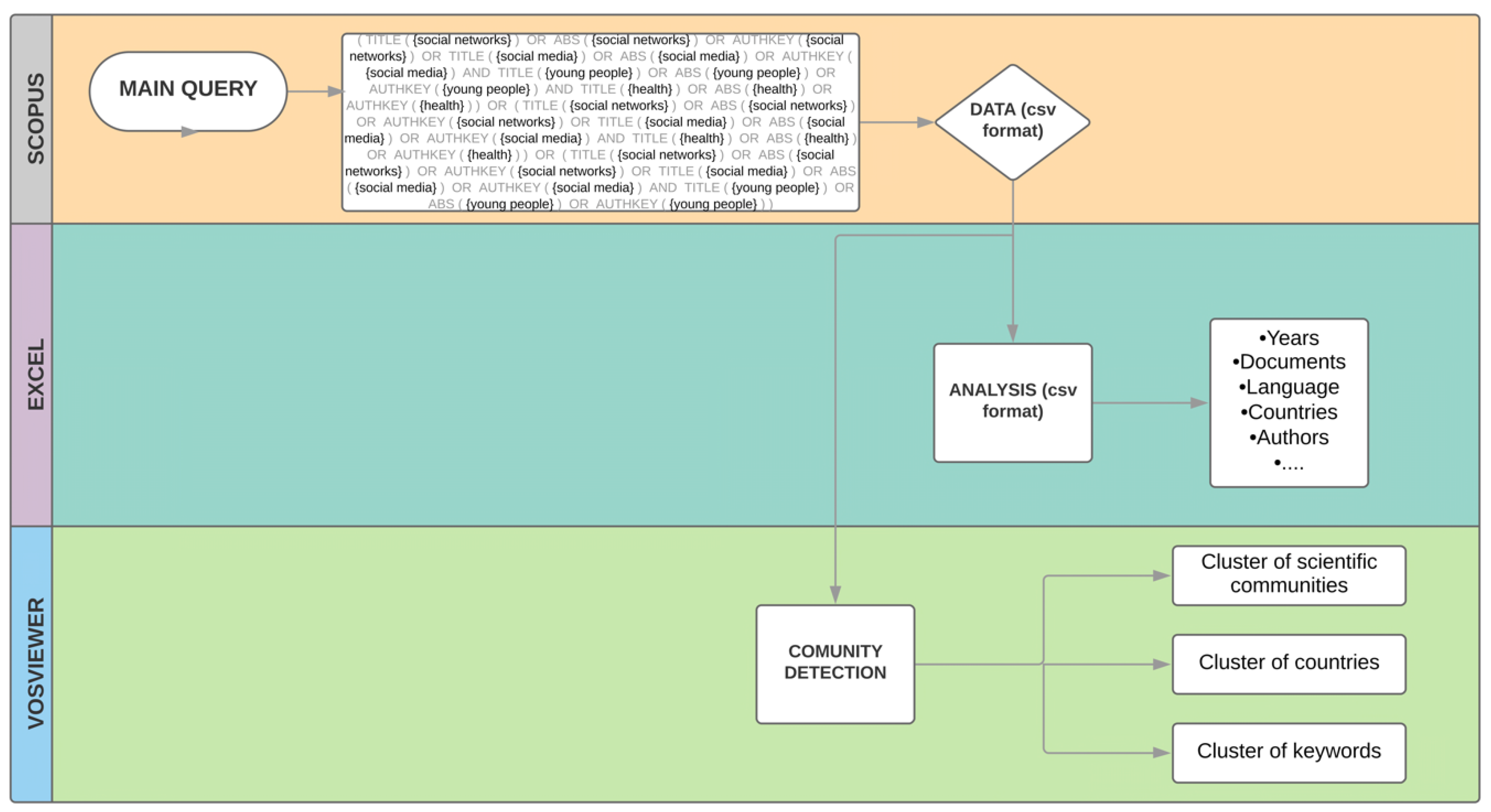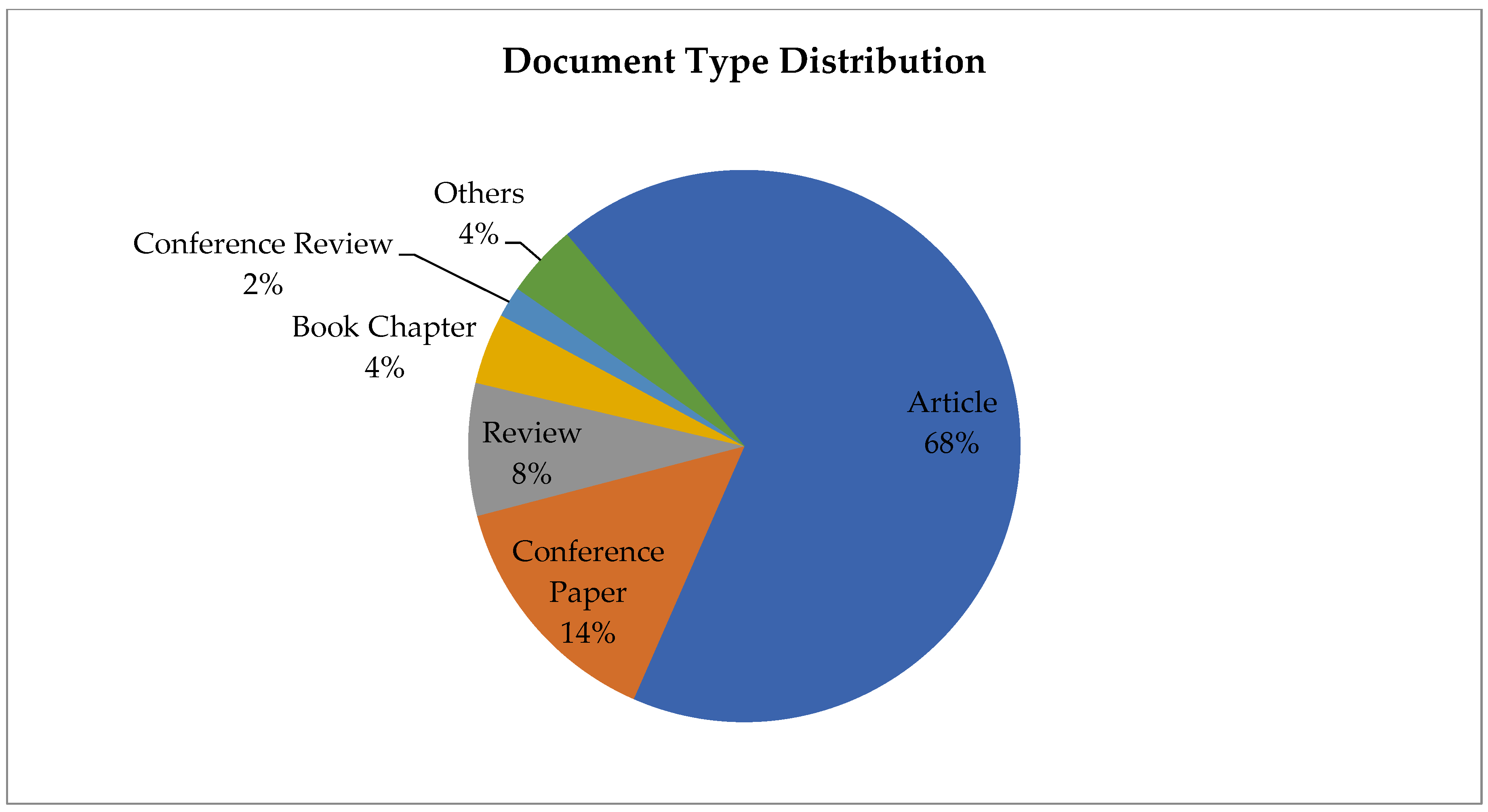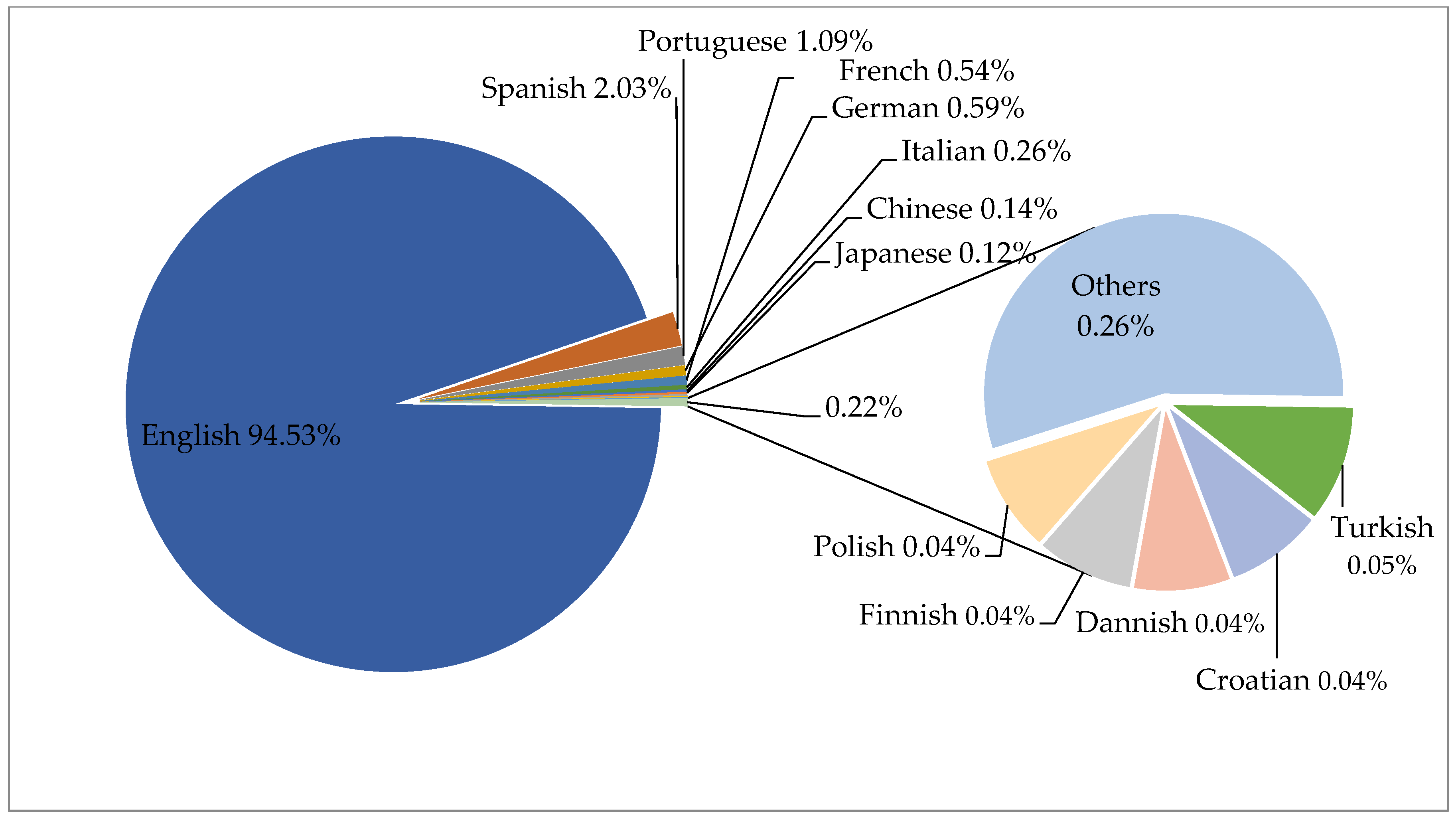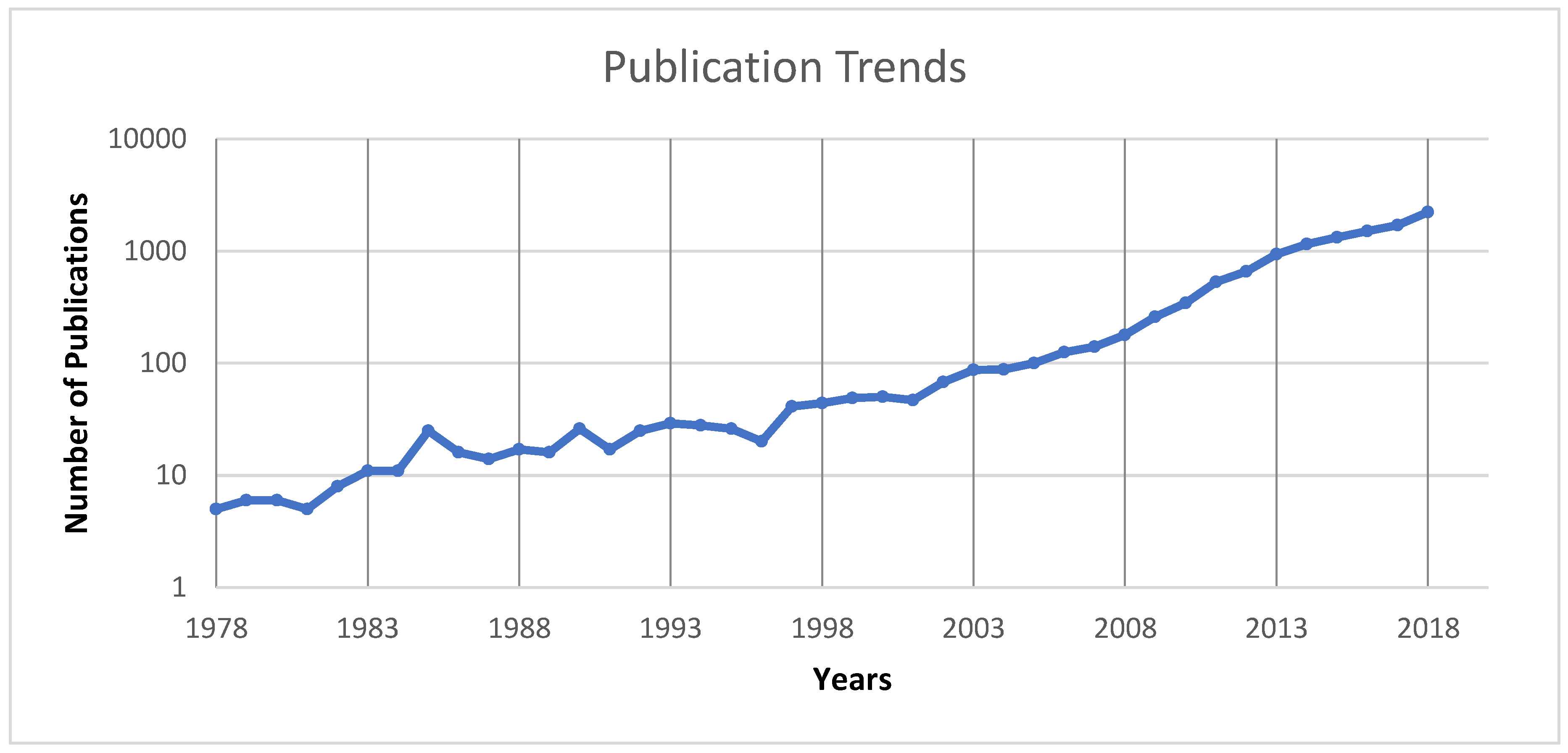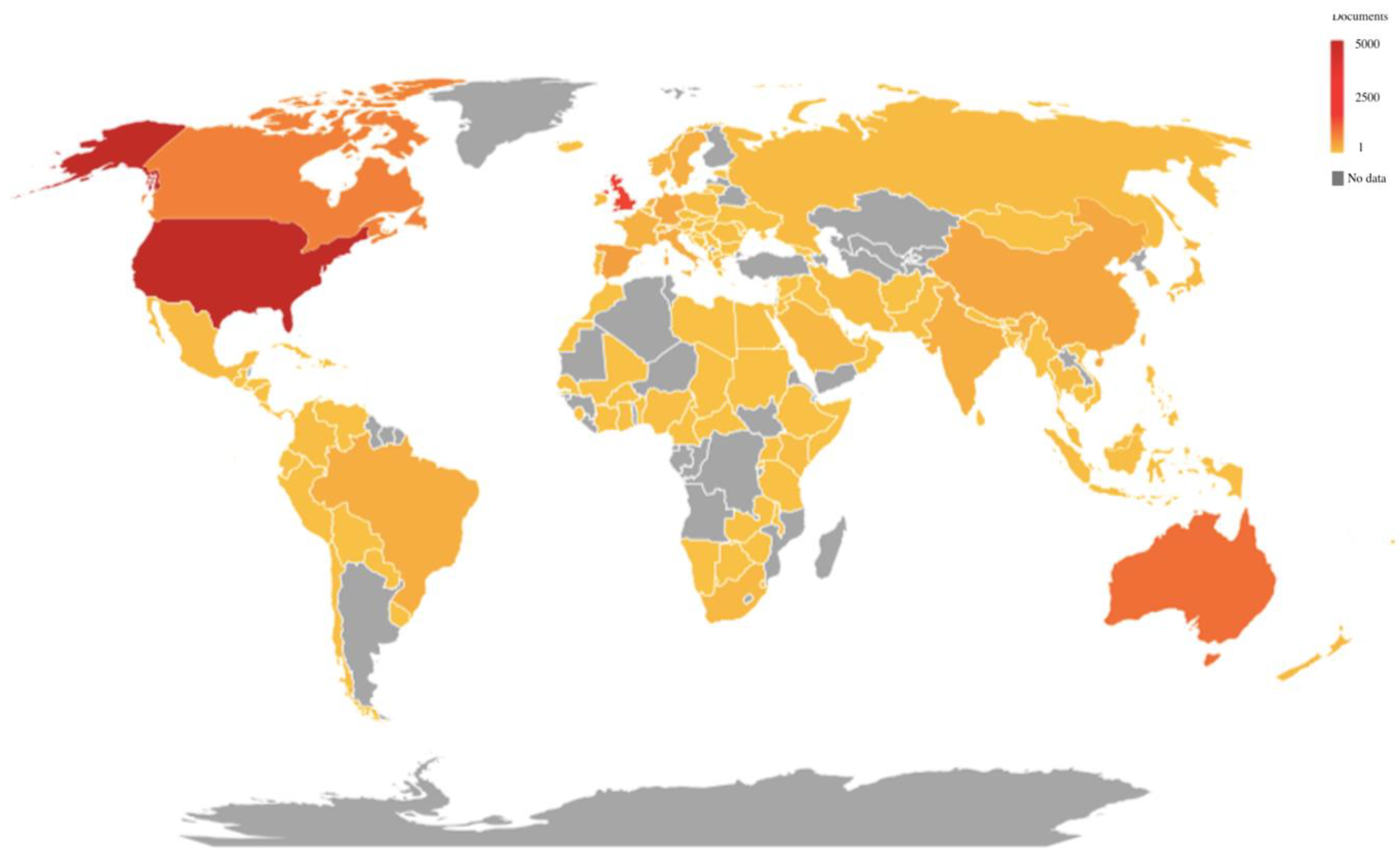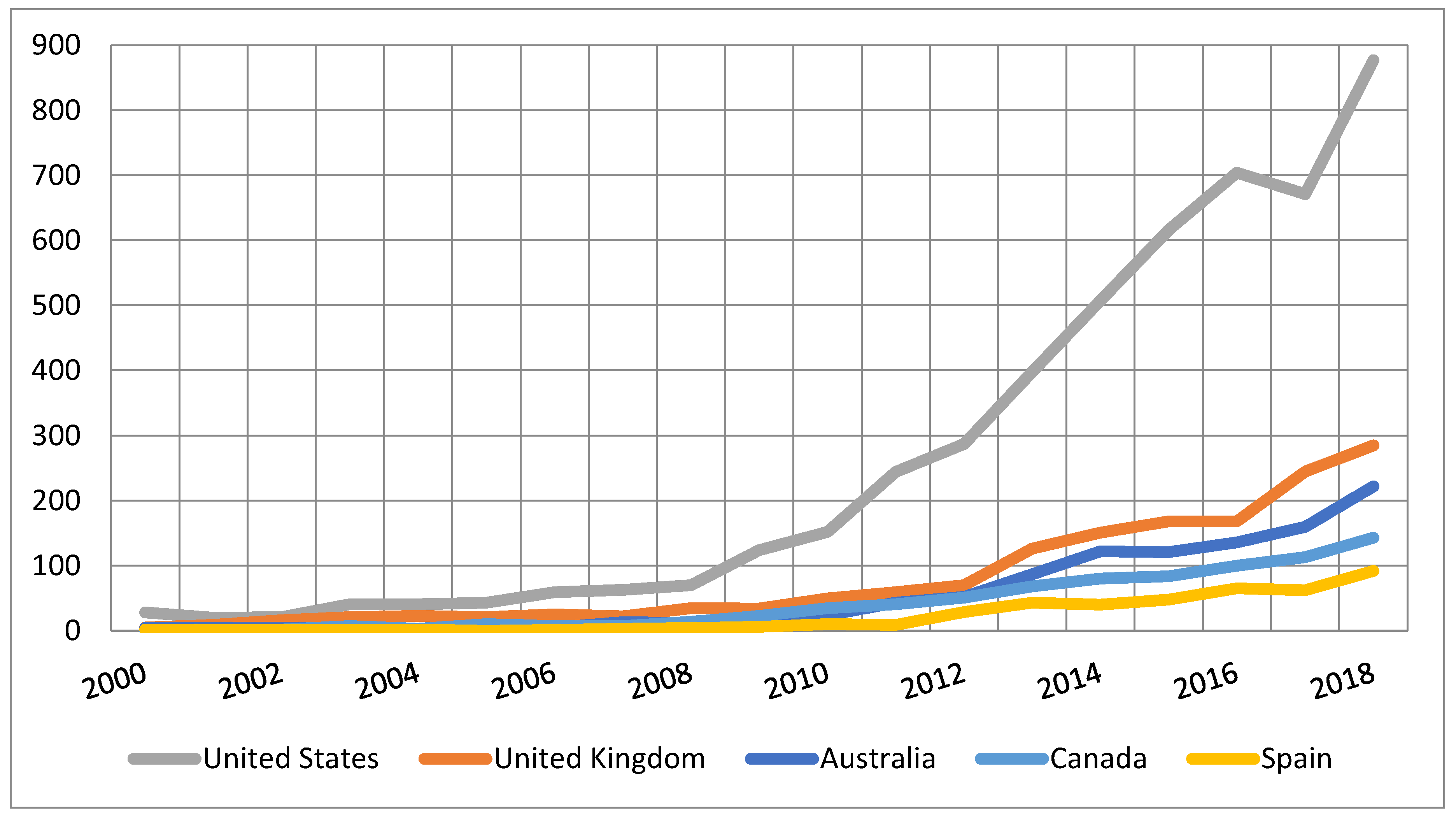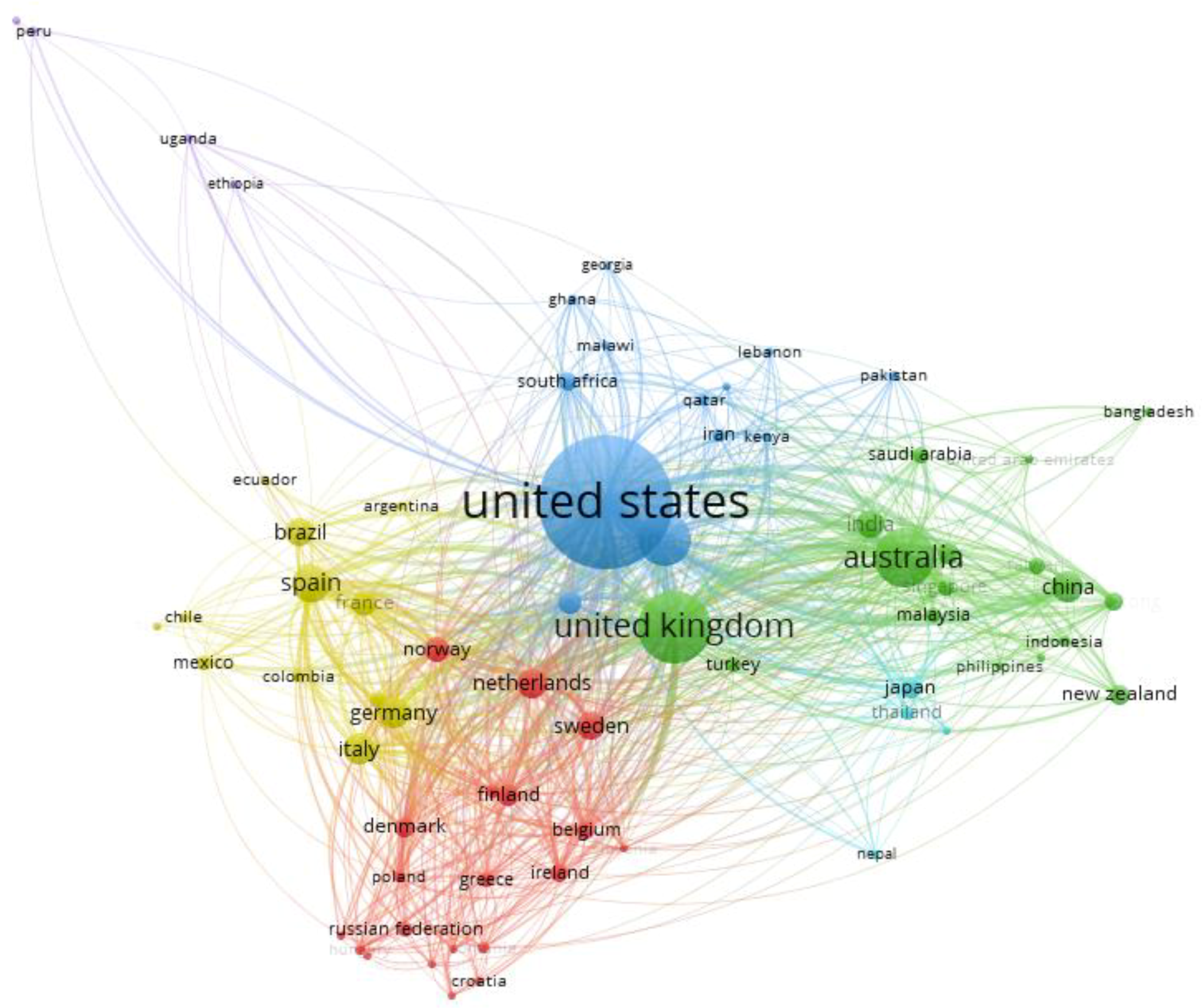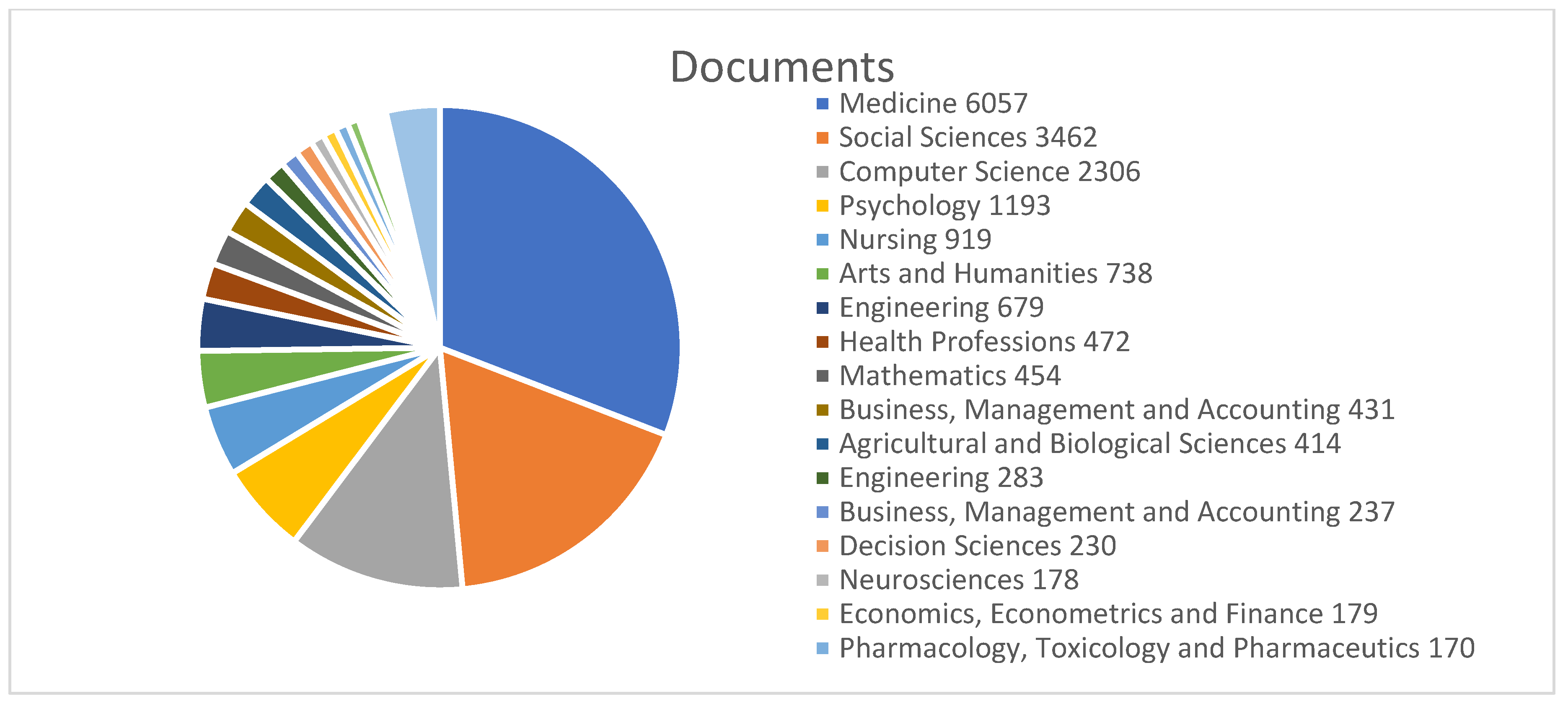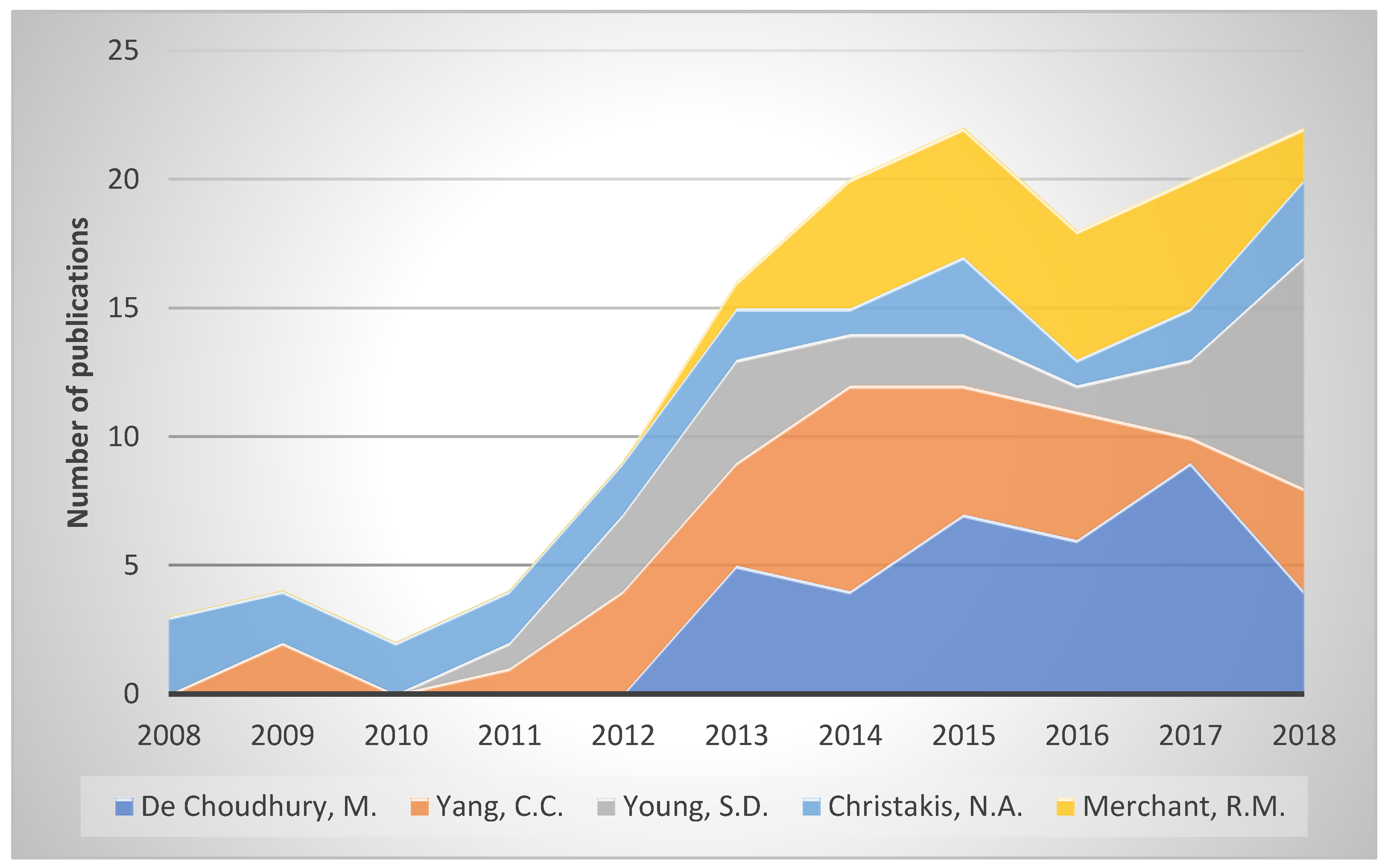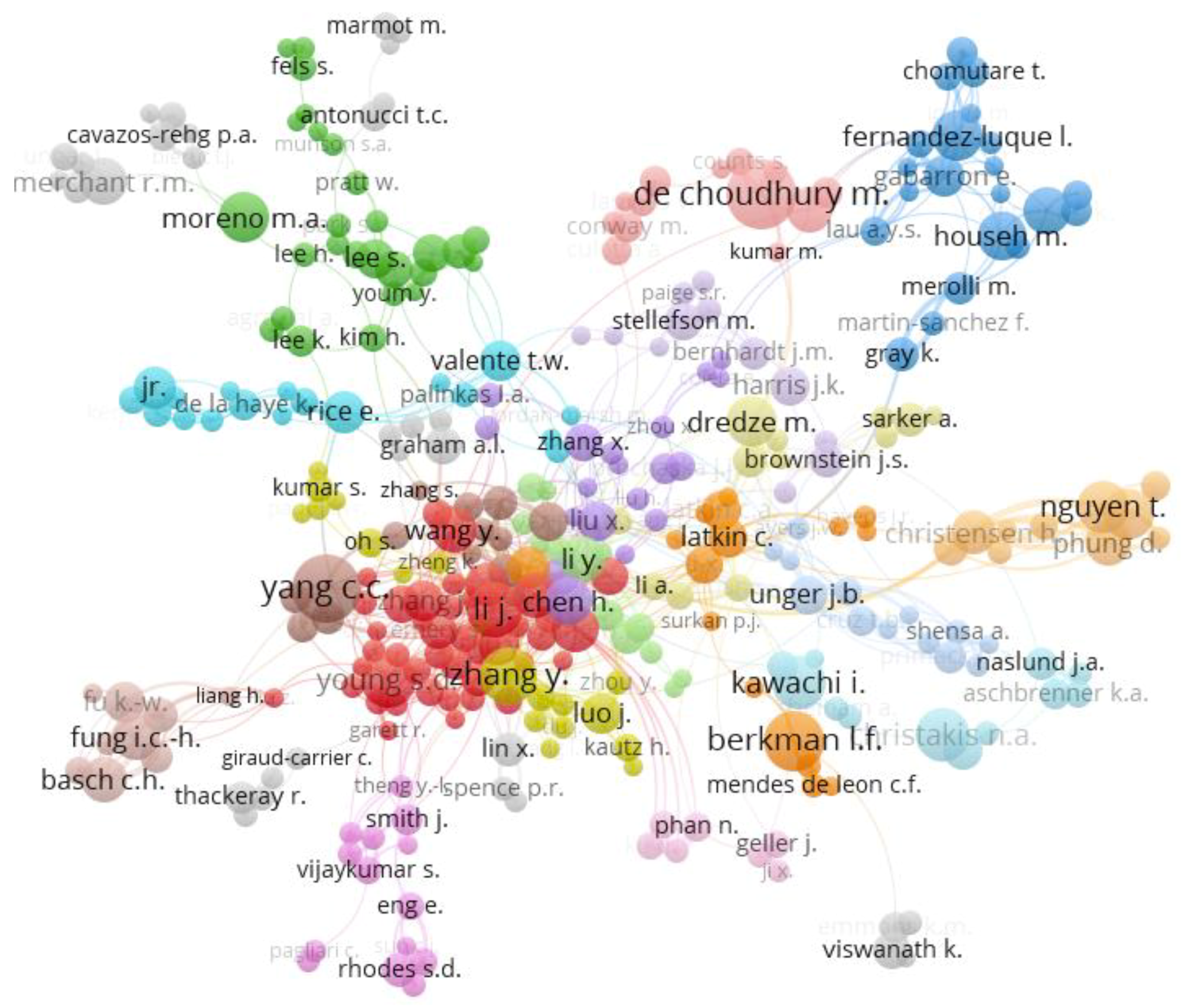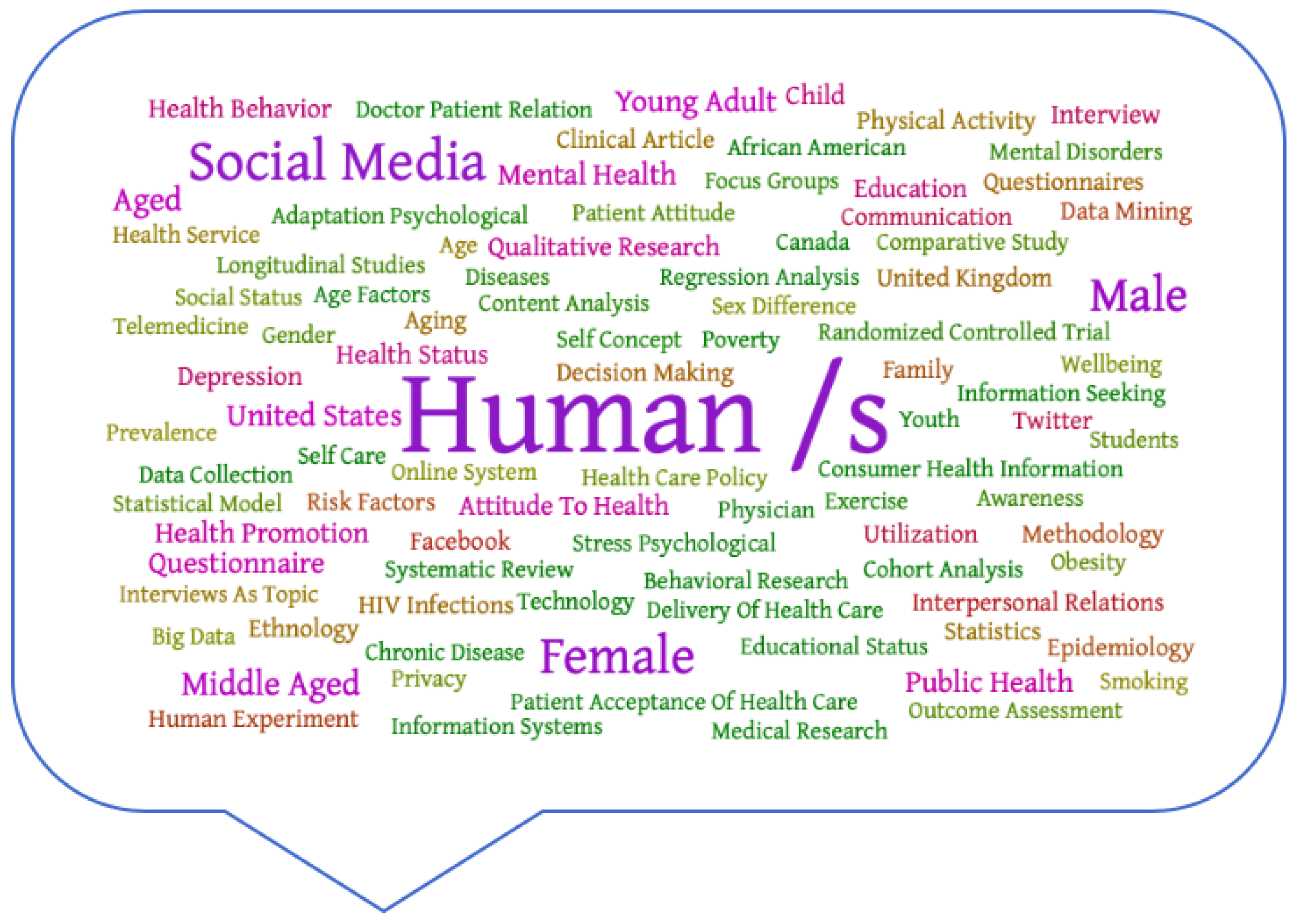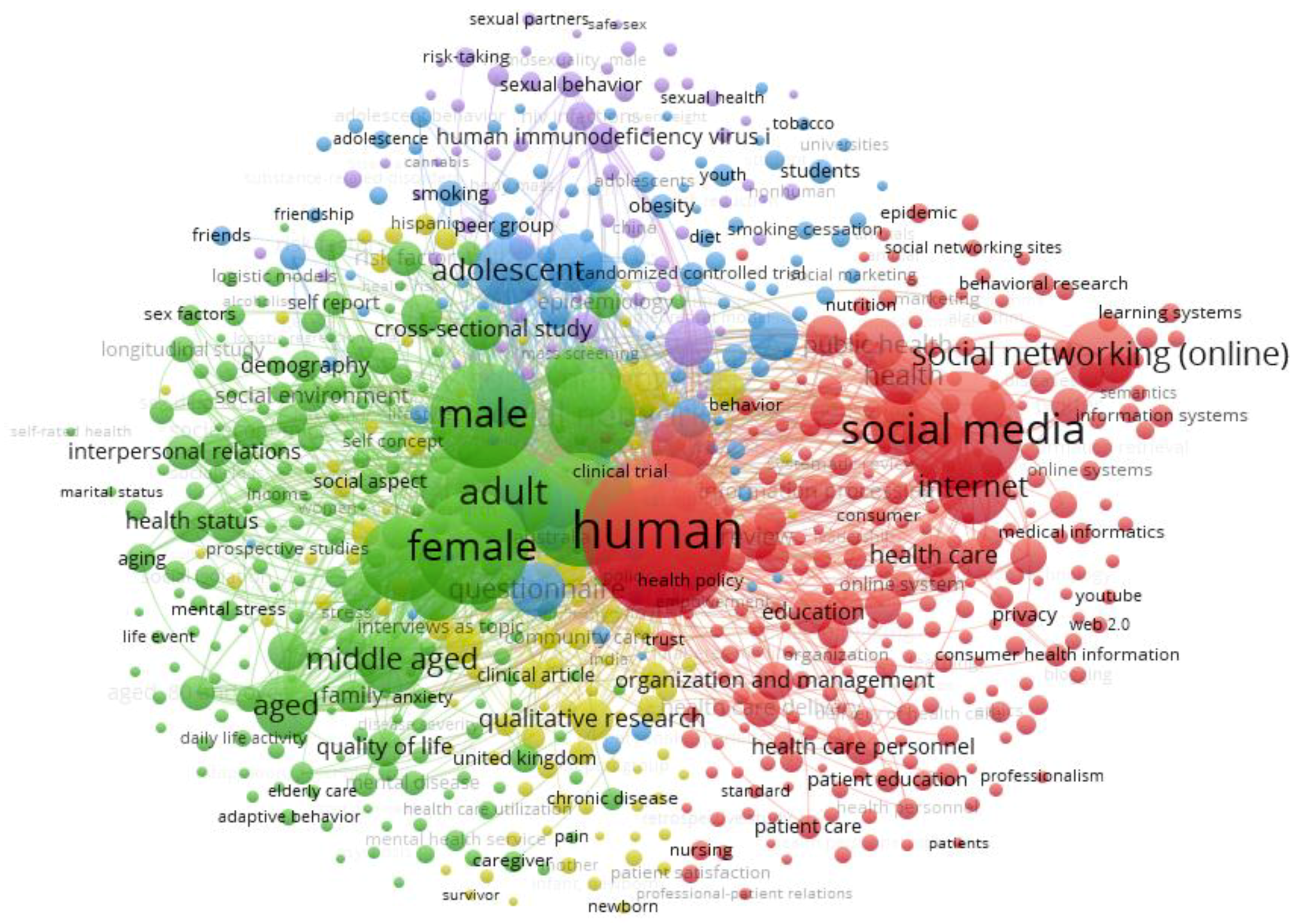Article frequency, disciplinary focus, topics, authors’ institutional affiliation, and country are all useful indicators of the popularity and type of research being undertaken in a scientific field, as well as its trends.
3.3. International Dissemination of Publications
Figure 5 shows the production of relevant articles per country between 1978 and 2018. Colors indicate the number of papers, from red (highest) to grey (no publications). The country with most publications was the United States (5205), followed by the United Kingdom (1577), Australia (1058), Canada (811), and Spain (423). Within these countries, the use of social networks has increased, and has even been potentiated by governments and institutions in order to promote healthy lifestyles or to provide group support for patients [
48]. In the case of Spain, the increase of publications related to social media and health might be linked to the growth in environmental performance, social performance, and corporate governance performance since 2002 [
49].
Figure 6 shows the trajectory of research publications in each of the five countries with the highest production of papers on social networks, young people, and health, revealing the highest increase occurred in the United States.
The social network map shown in
Figure 7 illustrates the pattern of international collaboration between study authors. This figure was obtained after applying the software VOSviewer v.1.6.11. to a .csv file of the data extracted from Scopus during the literature search.
Three countries dominate in the six clusters seen in
Figure 7 and
Table 2, namely: the United Kingdom, the United States, and Australia. The first cluster comprises eastern European countries and Nordic countries, led by Finland. The green cluster, which is the second most crucial cluster, is led by the United Kingdom. The United Kingdom is the node of this cluster, because of the number of connections with other countries, and the number of publications. This cluster also includes Australia as the second most relevant nucleus, with a lower number of connections than the United Kingdom. All of the countries from this cluster seem to be connected via economic and political relationships.
The blue cluster is third in importance, and is led by the United States, followed by Canada, and represents 24.2% of the publications. The yellow cluster is led by Spain, with connections to Latin America and Europe, representing 13.4% of publications on this topic. The purple cluster is linked to Latin America and African countries, led by Cuba. The last cluster is pink and is led by Japan, and is connected to a variety of different countries such as the United Kingdom, the United States, Australia, and New Zealand.
Of the countries that have published the most about social media in the health field, the United States stands out. Previous researchers have stated that the United States has dominated publications in different scientific fields, such as education. This tendency of publications to originate from the United States and a few other countries, such as the United Kingdom, has been attributed to a combination of factors, such as being English-speaking countries, authors coming from these countries, and the possible connections between researchers within the scientific community [
50]. These results and previous works further support the idea of the United States being the leader of scientific productions in the health field, and therefore in the topic of social media connected to health and young people.
The essential and significant role of the United States is also shown by the connections between authors and affiliations, most of which belong to the United States (
Table 3). Overall, these results might be explained by the fact that there may be economic, historical, geographical, and cultural influences between the groups, which can be applied to all of the clusters. In addition, the remaining clusters could be explained by specific topics relating to social networks, such as interventions or risks, and the type of young people that the research focused on.
3.4. Institutions Active in Relevant Research
In
Table 3, the 10 organizations with the highest rates of publication in the field of social networks related to health and young people are presented. Additionally, the top three keywords used in each of these institutions are included in this table.
The University of Toronto is in first position, with 158 documents, which is not surprising, as the Journal of Medical Internet Research is based at this location. Next is the University of Sydney, in second position with 157 documents, and the University of Michigan in third position with 155. In positions four–six are the University of North Carolina at Chapel Hill with 152, the University of Washington with 143, and the University of Melbourne with 140 documents published. Finally, Harvard Medical School has 132, University of California has 131, Johns Hopkins Bloomberg School of Public Health has 126, and the University of California has 123. It should be highlighted that the keyword used most often by these institutions is “human/s”, ranking in first place in all cases.
The increase of publications and the ranking of affiliations might be related to collaboration between authors. These collaborations have been previously studied by other authors, showing that, since 1997, collaborations in the United States or Canada have increased by 20% [
51]. Moreover, these factors have been linked to collaborations between the United States and the other countries, showing a possible node of union [
51].
Regarding the type of study implemented by each institution, according to Scopus, the results showed that all of the institutions focused on articles in the area of medicine, followed by the area of social sciences. The central countries with a higher number of publications were the United States, United Kingdom, and Canada. Finally, the most common keywords used according to Scopus were “human/s”, “female”, “articles”, “male”, and “social media.”
3.6. Determination of Scientific Groups and Utilization of Keywords
A further analysis was carried out based on the dominant authors in the field of social networks related to the health of the young.
Table 6 and
Figure 9 represent the scientific productions of the top five researchers focused on this subject during the last decade. De Choudhury, M. tops this field, with 35 documents over 10 years. Nevertheless, this author has an h-index of 28, lower than Christakis, N.A., with an h-index of 71, and Merchant, R.M., with an h-index of 32. Following this, according to the h-index, was Yang, C.C. with 23 and Young, S.D. with 22. Although De Choudhury, M. has a lower h-index compared to Christakis, N.A. or Merchant, R.M., the total number of documents published by this author, 2776, is higher than for any of the other authors.
All of the authors with the highest frequencies of publication are from the United States. These results match the previous results, which showed the high impact and leading role of the United States in research on social media applied to the health field.
However, possible critical authors in the field of health and social media, such as Eysenbach, G., with an h-index of 44, were not included in the previous analysis, based solely on the number of documents they authored on this topic.
Table 7 shows the 10 top authors of documents on this topic, with h-index, citations, total publications, and the year of the first publication included. Moreover, the author ID has been included so as to differentiate the authors with the same name, as any other researcher may access these details.
This table shows how younger authors have fewer publications, a lower h-index, and fewer publications. This is important to highlight, as the number of publications in this topic is not fully representative of the relevance of the authors.
Like any community, the scientific community is deeply connected, creating an interactive and dynamic network. This type of community usually has a central nucleus that is cohesively connected to other elements from the community that are less representative. The scientific community is generally replicated by clusters from other groups.
Clustering is a significant issue in the current work. Recognizing these groups has relative importance to the topic of study, as determining them makes it possible to define the quantity and quality of the existing associations between the authors of different institutions and areas of knowledge. The existence of interactions between different thematic areas, such as medicine and engineering, has been established [
54]. The algorithmic mapping technique used by the software VOSviewer [
41] was applied in order to identify and measure the association between authors. VOSviewer’s algorithm focused on the detection of items in a low-dimensional space, so that the distance between two items is a precise indicator of their affinity.
Figure 10 depicts the clusters of the scientific communities of the authors. This figure displays the interactions between the principal authors and remaining researchers in the field of social networks related to the health of young people. The first cluster, led by Young S.D., is the greatest, with 43 authors. The following cluster (green) comprises 27 authors, of which the top author is Moreno, M., with 21 documents. The top author in collaborations and publications is De Choudhury, M., with 35 publications and 22 collaborators. On this basis, the second author is Yang, C.C., with 434 publications and 34 collaborators.
Another analysis we carried out was the determination of the keywords used in the publications in this field. During the last four decades, from the 11,966 documents found, the most common author keywords used were “human/s”, utilized in 10,936 items, followed by “social media” (3937 items), and “article” (3561 items).
Table 8 illustrates the 40 most important keywords used in relevant documents during the last four decades.
The analysis of the authors’ keywords showed that most of the relevant keywords are commonly utilized for this topic. Nevertheless, it is essential to highlight that the term “human/s” was probably used to differentiate from animal research, rather than because of significance to the topic.
Based on these keywords, the results might imply the transversal inclusion of social media in the health field, from mental health to diabetes. However, it is essential to highlight that the keywords and topics of the studies also represented different points of view, such as on the side effects of using social media [
55].
Overall, the study of keywords in scientific works is highly relevant, as this determines the trends of publications and the follow-up of these publications. In this sense,
Table 7 shows how similar concepts are often written differently; for example, “social media”, “Internet”, or “adolescent”.
Figure 11 depicts a cloud of words, where the dimension of each word represents the significance of the keyword related to the number of documents in which it is used. The increased use of the term “social media” may be related to the increased use of platforms such as Facebook, Twitter, or Instagram [
31,
35,
56]. The growth of other words, such as “health promotion” or “eHealth”, might be related to the development of telemedicine and studies focused on new technologies and health [
57,
58,
59].
Figure 12 displays the map of co-occurring keywords selected by researchers from the documents we analyzed that focused on social networks and the health of young people. The VOSviewer software with the Vos mapping technique was used to develop
Figure 12. Each color symbolizes the separation between keywords, concerning the thematic area for which these colors have been selected. In addition, the dimension of the circles displays the frequency of use of each word, and the lines linking each circle show the associations among the different keywords used in the publications.
In this analysis, “human”, “social media”, and “article” are the most commonly used words.
Table 8 shows the essential keywords used by the five top groups identified in the subject of social networks related to health and young people [
60,
61,
62].
Social networks are used for multiple reasons related to health, including feedback, creating a support group, health interventions, or to determine the influence of these interventions [
63,
64,
65].
Table 9 shows the main characteristics of the clusters from
Figure 12, showing how the five clusters were found. The most important, the red cluster, focuses on social media and health education. The green cluster focuses on social networks and mental health, which matches the latest studies focused on preventing mental health problems in children and teenagers [
66,
67,
68]. The third cluster focuses on how social media may play an essential role in prevention programs for adolescents. A comparison of the findings from this cluster with those of other studies confirms the important role that social media may have in preventing health problems in younger people [
67,
69]. This is consistent with our earlier observations and previous research, which showed that social networks may be preventative and help-seeking tools for young people with mental health problems, such as drug use, depression, or addiction [
70]. The fourth cluster points out the relationship between ethnicity and health aptitude from a qualitative perspective. These results reflect those of Sunil and Xu (2019), who found that ethnicity and cultural background play an important role in health [
71,
72]. The purple cluster is focused on young people and the relationship of social networks to sexual health. This influence has been previously studied as being both positive and negative; either being used as a health intervention in patients with human immunodeficiency virus (HIV), or studied as a factor that contributes to the increase of HIV [
73,
74,
75].
Based on these connections, it could be concluded that the first objective of this study was accomplished, as the first, fifth, and sixth clusters focused on the positive use of these technologies in the health field in general. As previously stated, previous studies have corroborated the main perspectives of the recent trend of publications on using social media as education or prevention tools [
76]. The second objective has been partially completed, as the second, third, and fourth clusters focused not only on young people, but also adolescents. These results may be because of the interconnection between being a young person and being an adolescent; young adults are between 18 and 24 years old, and are often partially included in the definition of adolescence [
69].
